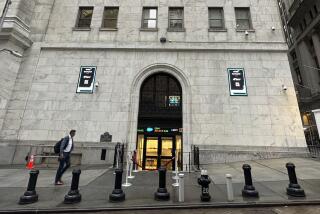Will first-quarter earnings derail the stock rally?
- Share via
The stock market closed out another winning quarter, overcoming Middle East turmoil, Japan’s nuclear crisis and a new downturn in housing.
But the biggest test may loom: Will corporate America extend its spectacular profit growth streak when first-quarter results begin to roll in later this month?
Total earnings of the companies whose stocks are in the Standard & Poor’s 500 index are expected to rise about 13% in the first period from a year earlier, the sixth consecutive double-digit percentage gain.
“Profits have done phenomenally well” in the economy’s recovery, said Dirk Van Dijk, senior equity strategist at Zacks Investment Research in Chicago. Companies have benefited from rebounding sales and from relentless cost-cutting.
That in turn has underpinned the stock market’s powerful rally over the last two years. The advance continued in the first three months of this year, with the Dow Jones industrial average finishing up 6.4% for the quarter after falling 30.88 points, or 0.3%, on Thursday to 12,319.73.
But soaring prices this year for raw materials — particularly oil — have raised fears that many companies’ first-quarter earnings may fall short of Wall Street’s expectations.
Athletic apparel giant Nike Inc. sounded an alarm two weeks ago when it reported results for its fiscal quarter ended Feb. 28. The company earned $1.08 a share in the period, below the $1.12 average of analysts’ estimates, as higher costs for cotton and transportation squeezed profit margins.
Nike’s shares have tumbled 11% since the earnings came out.
Companies often telegraph significant changes in the outlook for their earnings just before or after the end of a quarter, before reporting the actual results. There haven’t been many such “pre-announcements” so far about the effects of higher commodity prices, said Howard Silverblatt, senior index analyst at S&P in New York.
“I did expect to see more commentary on oil,” he said.
U.S. crude futures jumped $2.45 a barrel Thursday to $106.72, up 27% from one year ago.
Wall Street expects overall first-quarter profits of the S&P 500 companies to be up 13.3% from a year earlier, data firm Thomson Reuters calculates, based on analysts’ expectations for the operating earnings of the individual firms. That estimate is the same as it was March 4 and up from 12.2% at the start of the quarter.
Many companies have sought to offset rising raw-materials costs with price increases. Cereal maker General Mills Inc., which raised prices on some of its brands in November, reported earnings growth of 18% in its fiscal quarter ended Feb. 27, matching analysts’ expectations.
Still, some market pros worry that earnings estimates haven’t been adjusted for recent signs of weakness in the domestic economy, which may have weighed on companies’ sales.
Goldman Sachs had been projecting that the U.S. gross domestic product would grow at an annualized rate of 3.5% in the first quarter, after adjusting for inflation. But Goldman economists warned Monday of “significant downside risk” to that estimate. The reason: Consumers’ pace of spending, after inflation, has slowed this year.
Bank of America Merrill Lynch economists already have slashed their estimate of first-quarter GDP growth to 2.2% from 3.3% at the start of the year.
When GDP estimates are rising, companies tend to handily beat analysts’ earnings expectations, said Jim Paulsen, chief investment strategist at Wells Capital Management in Minneapolis. And falling GDP estimates can mean more profit reports will disappoint.
As a result, Paulsen said, “I’m a little worried about first-quarter earnings.”
But Wall Street clearly hasn’t been focusing on the potential for disappointment. After sliding in late winter as Middle East unrest spread and as Japan reeled from its devastating earthquake and tsunami and the resulting nuclear reactor crisis, stocks have rebounded sharply in the last two weeks.
The Dow, which hit a 21/2-year closing high of 12,391 on Feb. 18, ended the quarter within 0.6% of that level after falling 6.3% from mid-February to mid-March.
Broader market indexes posted price gains for the quarter of about 5% to 9%; some, including the Russell 2,000 small-stock index, ended March at new multiyear highs.
Market bulls say stocks’ resilience shows that most investors are staying focused on the idea that the U.S. economic recovery will continue.
If you buy that theme, then the primary alternatives to stocks — cash accounts paying nearly nothing and bonds at relatively low yields — don’t have much appeal, said Bruce McCain, chief investment strategist at Key Private Bank in Cleveland.
“So people have thrown in the towel and come back to equities,” he said.
The optimists’ case will be tested Friday, when the government reports on employment in March. Analysts were estimating that the economy added about 190,000 net new nonfarm jobs during the month.
Job growth has been the missing link in the nearly 2-year-old recovery. And although bigger job gains would be welcomed as a sign that the economy’s rebound can sustain itself, more hiring also would mean higher business costs, potentially depressing profit margins.
That would be a natural next phase in an economic recovery, as companies acknowledge that they can’t pile more work on an already stretched labor force and that they need to add staff.
The question facing corporate America is, “How much more blood from the stone can they wring, in terms of productivity growth?” Van Dijk said.
The obvious upside to job growth is that it would mean more people with money to spend, thereby creating more demand for goods and services and lifting sales.
But with many companies still focused intently on keeping costs down, S&P’s Silverblatt said he was doubtful that hiring would rise enough this year to pose a serious threat to corporate profit margins.
For workers’ sake, he said, “It would be nice to be wrong about that.”
More to Read
Inside the business of entertainment
The Wide Shot brings you news, analysis and insights on everything from streaming wars to production — and what it all means for the future.
You may occasionally receive promotional content from the Los Angeles Times.










